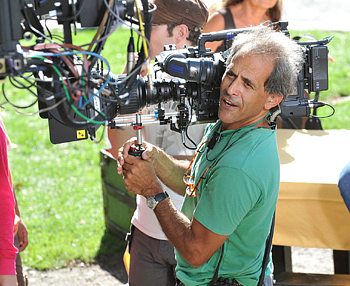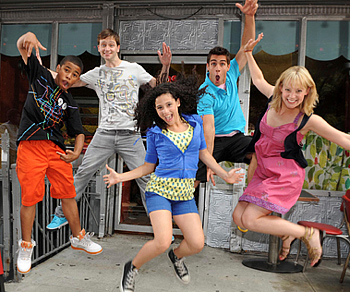All Powered Up
NEW YORK If you were a kid during the early-to-mid 1970s, chances are you spent more than a few afternoons parked in front of the television watching PBS’s remarkably hip educational series “The Electric Company.” Twenty years of reruns and two successful DVD releases later, the show’s lasting endurance serves as a reminder of its nearly 40-year influence on the minds of both adults and children.
That popularity is what prompted Sesame Workshop (nee Children’s Television Workshop) to relaunch the educational franchise for a contemporary audience, with a focus on contemporary issues, in a contemporary style. The new Electric Company retains the original’s focus on reading skills and is aimed at the same demographic (and opens with the memorable, “Hey you guys!!”), but for all intents and purposes it is an entirely unique entity. Instead of a sketch-driven multicamera setup, the show is now a single- to two-camera location-based narrative set in a natural-foods diner somewhere in “the big city,” where a not-so-secret society known as the Electric Company meets. The multicultural cast of four semi-superheroes has pledged to use their powers for good—they can scramble, recall, project and animate words in astounding ways—but plotting against the Company is a clutch of comical misfits known as the Pranksters.
HIGH STYLE, LOW COST

Bill Berner sets up some double coverage on location with "The Electric Company." Producers had the pilot shot with the Panasonic AG-HVX200 and had a good experience with the P2 workflow. When series director of photography Bill Berner came on board, he saw an opportunity to make the show as cinematic as possible.
“They were looking for a fairly high-style show on a limited dollar,” describes Berner, whose credits include Sesame Street and The Cosby Show. “When I was brought in, I very much wanted to do the show with a 2/3-inch-format HD chip because I wanted to reduce the depth of field.”
Berner ran a series of tests on a battery of 2/3-inch P2 cameras, including the AG-HPX500, AJ-HPX2000 and AJ-HPX3000. In the end, the HPX3000 was chosen for a number of reasons, one of which is its ability to shoot native 1920x1080 HD using AVC-Intra 100, Panasonic’s newest codec.
Berner’s biggest concern going into the job was that more than half of The Electric Company would be shot outdoors in Manhattan’s parks and gardens and on sidewalks and rooftops. He also knew he’d be limited by his lighting package and squeezed by the highly mobile nature of the production, taking on as many as three locations in one day. Still, the exteriors had to look their best, and one of the benefits of AVC-Intra 100 is that it records a highly compressed 10-bit image, which affords a wider grayscale than the 8-bit DVCPRO HD. With some additional tweaking to the camera’s Dynamic Range Stretching (DRS), gamma and knee controls, Berner and digital imaging technician (DIT) Dave Satin were able to turn the HPX3000’s nine stops of latitude into 10 (rating the camera at ASA 320). “We’re pretty free with our range of shadows and highlights, more free than I’ve ever been on any series I’ve shot,” Berner remarks.
Each 26-minute episode features a 15-minute narrative, broken up by what Berner describes as “modules”—unrelated animations, music videos and other live-action pieces. “There’s a fair amount of special effects and greenscreen work in the show,” he notes. One of the kids’ special powers is the ability to conjure up luminescent “word bubbles,” which they can throw and stick to walls. In another module, the chef at the diner (played by Shockwave, aka. Chris Sullivan), beatboxes his way through a phonics lesson on a pair of CG turntables. To capture the live-action elements as cleanly as possible, Berner was more than obliged to take advantage of the HPX3000s expanded 4:2:2 color space.
“I wouldn’t consider doing keys in anything but 4:2:2,” he says.

"The Electric Company's" Keith, Shock, Jessica, Hector and Lisa jump with excitement at the Electric Diner. Unlike some of the children’s shows Berner worked on in the past, shooting The Electric Company has been a relative snap. “We’re usually not dealing with high-chroma colors. It’s human beings all the time, you sort of know what your flesh tones are, and the biggest concerns are balancing those tones out,” the cameraman remarks.
A SECOND SET OF EYES
To set the look for the show, he collaborates closely with Satin. “I’ve known David a long time. He knows my taste in pictures, so he’s become a second set of eyes for me,” says Berner, who often does double-duty as the “B” camera operator. He keeps an external Panasonic 7-inch widescreen BT-LH80W LCD mounted to his “B” cam with the standard-def input of “A” (operated by Aaron Medick) on a separate input, allowing him to check framing at the beginning of each shot. Still, “Because I’m always on set and I’m operating, I don’t have as much of a chance as I would like to have my eyes on the ‘A’ camera, so it’s incredibly important that we have an extra set of eyes that I trust looking at picture,” he adds.
Satin’s responsibility is to make sure that all the cameras match. The production will occasionally employ the HPX500 for slow-mo shots, and sometimes even an HVX200 for shots with a home video feel. Berner was so impressed with the HPX3000 in testing that he purchased one for himself and rents it to the production, while the second HPX3000 and HPX500s are rented from Liman Video Rental Co. in New York. Berner is also shooting with two different 2/3” cine-style video lenses: a Fujinon HAc 13x4.5B (4.5-59 mm) on the “A” cam and Canon HJ21x7.5B (7.5-158 mm) on the “B” cam.
“All lenses resolve the color white differently,” Satin explains. “Prism optics will sometimes cause the white light in one lens to refract at a slightly different wavelength than another lens. The trick is to get both cameras to see the same shade of white.” To conform the disparities between the two lenses, Satin sets his scene files using Labsphere’s integrating sphere, a device consisting of a hollow cavity with a white interior coated for high diffuse reflectivity. “It’s like a white card,” he describes, “but it ensures an even color temperature and intensity both horizontally and vertically.”
Satin is also responsible for making sure that all tapeless workflow systems are always working, as well as overseeing media management. Berner notes that in this respect, the role of the DIT may not be so far of a jump from the original Electric Company’s days of technical directors and tape ops. “There have always been video operators,” he says. “The biggest change is that the DIT is downloading the cards to the external hard drives and getting reports back from post that they were able to get the footage ingested successfully.”
Each HPX3000 is equipped with three P2 cards: two 32 GB and one 16 GB. “We treat the cards like videotape rolls,” Satin explains. “I back up the cards on two G-RAID drives. I copy the files using the DUO PCMCIA adapter plugged into my MacBook Pro’s CardBus slot, and the G-RAID is connected via FireWire 800. I routinely get transfer speeds of over 280 MBps, which means a 32 GB card is backed up in 18 minutes.”
The Electric Company is edited at Sesame Workshop with Final Cut Pro in Apple’s ProRes 422 codec and is delivered to PBS on 1080i/59.94 videotape.
PBS airs the series in both HD and SD (letterboxed), which allows Berner to utilize the full 16:9 frame. “The HPX3000 provides a beautiful, filmic look to The Electric Company,” he says. “The camera has excellent dynamic range, signal-to-noise and colorimetry. I love the fact that we’re recording 1920x1080 AVC-Intra at the chip, so there’s no upscaling of the picture. What we’re recording is what’s getting laid down.”
The professional video industry's #1 source for news, trends and product and tech information. Sign up below.
